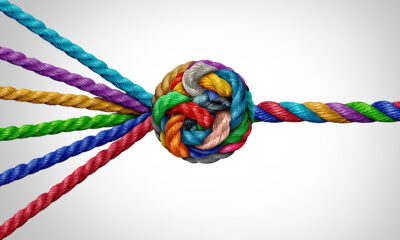MARKETING
More Leads (for Less) with Facebook Ads

Digital advertising is getting more expensive every year, and if you rely on Facebook’s ad platform to generate leads for your business, you can’t afford to sit idle.
Luckily, there are a few ways to maximize your lead generation without spending more on ads.
In this article, we’ll share five (5) things you can implement today that – when done right – will help your business generate more leads (for less) with Facebook ads.
#1. Retarget, Retarget, Retarget
There’s a good chance you’re using “cold” audiences within your Facebook ads to target the type of people who might be interested in your product, service, event, etc.
Cold audiences are usually made up of interests Facebook thinks will match up with a customer, for instance: “gardening” interests. A person interested in “gardening” is a great cold audience for a business that sells water hoses.
If we were to use only “cold” audiences, we’d need to spend more money to reach more people and hope that just through sheer numbers we’d get a few people to click on our offer.
A more effective strategy would be to show ads to cold audiences and retarget audiences simultaneously.
Retargeting audiences are people who’ve interacted with your ads or your online assets (website, social media profiles) before and are thus less likely to ignore your ads completely.
Good audiences to retarget are:
- People who’ve interacted with your “cold” Facebook ads
- People who’ve interacted with your Facebook page/profile
- People who’ve visited your website or landing pages
These are “warmer” audiences, and because you’re helping Facebook narrow down who you’d like to reach, it can be much cheaper to serve ads to these smaller groups.
Retargeting audiences are simple to create and will help you reach a better audience for less money.
#2. Widen The Net
Okay, so we already talked about “cold” audiences vs. “warm” audiences and how we can save money on ads by utilizing retargeting – but that doesn’t mean we should write off cold ads completely.
Sometimes we can increase our number of leads and lower advertising costs by making our audiences even colder. I know it sounds counterproductive, but hear me out.
Facebook’s algorithm is in charge of showing Facebook users the content they’d most likely interact with – this is true of regular everyday posts and paid ads.
In the past, these algorithms were inconsistent and sometimes downright wrong about who they’d show our ads. This led advertisers to take a more hands-on approach and develop complicated sales funnels and ad targeting strategies.
Those “hands-on” days are all but gone. The algorithm has evolved (with a bit of help from Meta’s teams of engineers) and now knows our customers better than we ever could.
Simply removing interests from your ad sets or targeting a county instead of just a single town will give Facebook’s algorithm a larger pool of people to show ads.
These targeting changes have been shown to reduce ad costs and increase lead volume by showing ads to people that aren’t typically targeted by your industry.
#3. Restrict Ad Spend
Sometimes giving Facebook more ad budget to work with can harm our campaign results.
This isn’t always the case, but often when we give Facebook too much money, too fast, it will panic and spend our money ineffectively.
See, the algorithm wants to give us results but, at the same time, spend our money quickly.
If we give it a little money to use: it will stretch that money as far as possible in a desperate attempt to get us results.
If we give it a lot of money too fast: it will show our ads to anyone and everyone – regardless of whether they’re our target audience or not.
The trick is to scale our ad budget slowly, and if we’re getting results (increased sales or lead volume), leave the budget alone!
We want to train the algorithm to “work” for our money – don’t feed it too much, too fast.
#4. Use Video Content
Video content has been trending for a while, with video consumption hitting new all-time highs on platforms like YouTube, Instagram, and Facebook this year.
Consumers are more likely to engage with video content, which means our ads are more likely to be watched, and our offer is paid attention to.
Videos are also more likely to be shared, so our audience put our video ads in front of their friends without us spending money to reach those new people.
The bottom line is that you should use video content in your ads. If you aren’t, you’re a rare breed, and it could be hurting your results.
In a recent survey, 93% of businesses landed a new customer by using video in their social media strategy and even ranked video #1 in terms of ROI.
#5. Nurture “old” leads
You’ve generated a lead through Facebook – now what?
In most cases, you’ll reach out to that lead, send them an offer, call them, etc., but if you can’t generate a sale from that lead, is it dead?
We can get more life out of your leads by putting them into a separate “nurturing” funnel.
You’d be surprised how often a lead that isn’t ready to buy today will be ready to buy 6-12 months down the road. If you aren’t top-of-mind for that lead when they are finally ready to buy, they’ll likely buy from your competitor or the next person to show them an ad.
We don’t want to lose that sale, so let’s keep in touch!
We can create a simple nurturing funnel with just two handy tools:
CRM
Customer Relationship Management software is any software that allows you to keep track of your existing customers and new prospects.
CRM software is available for every industry and every budget; whether you need a CRM for real estate investing, retail, healthcare, or eCommerce – the options are staggering.
Most good CRMs will come with a customer organization panel, allowing you to tag customers or new leads and add notes to them.
Email Marketing
Email marketing software, like CRMs, comes in all shapes and sizes, have numerous useful features, and universally allows the scheduling of marketing emails.
We’ll want an email marketing software that connects with our chosen CRM and allows auto-scheduled emails or “drip” emails.
Using these two tools together, we’ll be able to track and schedule automatic “check-in” emails with our old leads.
If they respond to our automated emails, we’ll be notified and can pick up the conversation to close a sale.
If they don’t respond, our email marketing software will send them periodic emails to keep nurturing them towards a response.
That’s it – we now have a system for keeping “old” Facebook leads “fresh.”
Final Thoughts
Facebook ads are an excellent tool for lead generation, but as more businesses take their advertising online, the landscape will continue to get more competitive.
Using tips like the ones shared in this article can go a long way towards helping your business stand out from competitors and keep your ad spend under control.
Fun fact: most of these tips will work for other advertising platforms (like Google), so feel free to try these tactics in places other than Facebook!
MARKETING
YouTube Ad Specs, Sizes, and Examples [2024 Update]
![YouTube Ad Specs, Sizes, and Examples [2024 Update] YouTube Ad Specs, Sizes, and Examples](https://articles.entireweb.com/wp-content/uploads/2024/06/YouTube-Ad-Specs-Sizes-and-Examples.jpg)
Introduction
With billions of users each month, YouTube is the world’s second largest search engine and top website for video content. This makes it a great place for advertising. To succeed, advertisers need to follow the correct YouTube ad specifications. These rules help your ad reach more viewers, increasing the chance of gaining new customers and boosting brand awareness.
Types of YouTube Ads
Video Ads
- Description: These play before, during, or after a YouTube video on computers or mobile devices.
- Types:
- In-stream ads: Can be skippable or non-skippable.
- Bumper ads: Non-skippable, short ads that play before, during, or after a video.
Display Ads
- Description: These appear in different spots on YouTube and usually use text or static images.
- Note: YouTube does not support display image ads directly on its app, but these can be targeted to YouTube.com through Google Display Network (GDN).
Companion Banners
- Description: Appears to the right of the YouTube player on desktop.
- Requirement: Must be purchased alongside In-stream ads, Bumper ads, or In-feed ads.
In-feed Ads
- Description: Resemble videos with images, headlines, and text. They link to a public or unlisted YouTube video.
Outstream Ads
- Description: Mobile-only video ads that play outside of YouTube, on websites and apps within the Google video partner network.
Masthead Ads
- Description: Premium, high-visibility banner ads displayed at the top of the YouTube homepage for both desktop and mobile users.
YouTube Ad Specs by Type
Skippable In-stream Video Ads
- Placement: Before, during, or after a YouTube video.
- Resolution:
- Horizontal: 1920 x 1080px
- Vertical: 1080 x 1920px
- Square: 1080 x 1080px
- Aspect Ratio:
- Horizontal: 16:9
- Vertical: 9:16
- Square: 1:1
- Length:
- Awareness: 15-20 seconds
- Consideration: 2-3 minutes
- Action: 15-20 seconds
Non-skippable In-stream Video Ads
- Description: Must be watched completely before the main video.
- Length: 15 seconds (or 20 seconds in certain markets).
- Resolution:
- Horizontal: 1920 x 1080px
- Vertical: 1080 x 1920px
- Square: 1080 x 1080px
- Aspect Ratio:
- Horizontal: 16:9
- Vertical: 9:16
- Square: 1:1
Bumper Ads
- Length: Maximum 6 seconds.
- File Format: MP4, Quicktime, AVI, ASF, Windows Media, or MPEG.
- Resolution:
- Horizontal: 640 x 360px
- Vertical: 480 x 360px
In-feed Ads
- Description: Show alongside YouTube content, like search results or the Home feed.
- Resolution:
- Horizontal: 1920 x 1080px
- Vertical: 1080 x 1920px
- Square: 1080 x 1080px
- Aspect Ratio:
- Horizontal: 16:9
- Square: 1:1
- Length:
- Awareness: 15-20 seconds
- Consideration: 2-3 minutes
- Headline/Description:
- Headline: Up to 2 lines, 40 characters per line
- Description: Up to 2 lines, 35 characters per line
Display Ads
- Description: Static images or animated media that appear on YouTube next to video suggestions, in search results, or on the homepage.
- Image Size: 300×60 pixels.
- File Type: GIF, JPG, PNG.
- File Size: Max 150KB.
- Max Animation Length: 30 seconds.
Outstream Ads
- Description: Mobile-only video ads that appear on websites and apps within the Google video partner network, not on YouTube itself.
- Logo Specs:
- Square: 1:1 (200 x 200px).
- File Type: JPG, GIF, PNG.
- Max Size: 200KB.
Masthead Ads
- Description: High-visibility ads at the top of the YouTube homepage.
- Resolution: 1920 x 1080 or higher.
- File Type: JPG or PNG (without transparency).
Conclusion
YouTube offers a variety of ad formats to reach audiences effectively in 2024. Whether you want to build brand awareness, drive conversions, or target specific demographics, YouTube provides a dynamic platform for your advertising needs. Always follow Google’s advertising policies and the technical ad specs to ensure your ads perform their best. Ready to start using YouTube ads? Contact us today to get started!
MARKETING
Why We Are Always ‘Clicking to Buy’, According to Psychologists

Amazon pillows.
MARKETING
A deeper dive into data, personalization and Copilots

Salesforce launched a collection of new, generative AI-related products at Connections in Chicago this week. They included new Einstein Copilots for marketers and merchants and Einstein Personalization.
To better understand, not only the potential impact of the new products, but the evolving Salesforce architecture, we sat down with Bobby Jania, CMO, Marketing Cloud.
Dig deeper: Salesforce piles on the Einstein Copilots
Salesforce’s evolving architecture
It’s hard to deny that Salesforce likes coming up with new names for platforms and products (what happened to Customer 360?) and this can sometimes make the observer wonder if something is brand new, or old but with a brand new name. In particular, what exactly is Einstein 1 and how is it related to Salesforce Data Cloud?
“Data Cloud is built on the Einstein 1 platform,” Jania explained. “The Einstein 1 platform is our entire Salesforce platform and that includes products like Sales Cloud, Service Cloud — that it includes the original idea of Salesforce not just being in the cloud, but being multi-tenancy.”
Data Cloud — not an acquisition, of course — was built natively on that platform. It was the first product built on Hyperforce, Salesforce’s new cloud infrastructure architecture. “Since Data Cloud was on what we now call the Einstein 1 platform from Day One, it has always natively connected to, and been able to read anything in Sales Cloud, Service Cloud [and so on]. On top of that, we can now bring in, not only structured but unstructured data.”
That’s a significant progression from the position, several years ago, when Salesforce had stitched together a platform around various acquisitions (ExactTarget, for example) that didn’t necessarily talk to each other.
“At times, what we would do is have a kind of behind-the-scenes flow where data from one product could be moved into another product,” said Jania, “but in many of those cases the data would then be in both, whereas now the data is in Data Cloud. Tableau will run natively off Data Cloud; Commerce Cloud, Service Cloud, Marketing Cloud — they’re all going to the same operational customer profile.” They’re not copying the data from Data Cloud, Jania confirmed.
Another thing to know is tit’s possible for Salesforce customers to import their own datasets into Data Cloud. “We wanted to create a federated data model,” said Jania. “If you’re using Snowflake, for example, we more or less virtually sit on your data lake. The value we add is that we will look at all your data and help you form these operational customer profiles.”
Let’s learn more about Einstein Copilot
“Copilot means that I have an assistant with me in the tool where I need to be working that contextually knows what I am trying to do and helps me at every step of the process,” Jania said.
For marketers, this might begin with a campaign brief developed with Copilot’s assistance, the identification of an audience based on the brief, and then the development of email or other content. “What’s really cool is the idea of Einstein Studio where our customers will create actions [for Copilot] that we hadn’t even thought about.”
Here’s a key insight (back to nomenclature). We reported on Copilot for markets, Copilot for merchants, Copilot for shoppers. It turns out, however, that there is just one Copilot, Einstein Copilot, and these are use cases. “There’s just one Copilot, we just add these for a little clarity; we’re going to talk about marketing use cases, about shoppers’ use cases. These are actions for the marketing use cases we built out of the box; you can build your own.”
It’s surely going to take a little time for marketers to learn to work easily with Copilot. “There’s always time for adoption,” Jania agreed. “What is directly connected with this is, this is my ninth Connections and this one has the most hands-on training that I’ve seen since 2014 — and a lot of that is getting people using Data Cloud, using these tools rather than just being given a demo.”
What’s new about Einstein Personalization
Salesforce Einstein has been around since 2016 and many of the use cases seem to have involved personalization in various forms. What’s new?
“Einstein Personalization is a real-time decision engine and it’s going to choose next-best-action, next-best-offer. What is new is that it’s a service now that runs natively on top of Data Cloud.” A lot of real-time decision engines need their own set of data that might actually be a subset of data. “Einstein Personalization is going to look holistically at a customer and recommend a next-best-action that could be natively surfaced in Service Cloud, Sales Cloud or Marketing Cloud.”
Finally, trust
One feature of the presentations at Connections was the reassurance that, although public LLMs like ChatGPT could be selected for application to customer data, none of that data would be retained by the LLMs. Is this just a matter of written agreements? No, not just that, said Jania.
“In the Einstein Trust Layer, all of the data, when it connects to an LLM, runs through our gateway. If there was a prompt that had personally identifiable information — a credit card number, an email address — at a mimum, all that is stripped out. The LLMs do not store the output; we store the output for auditing back in Salesforce. Any output that comes back through our gateway is logged in our system; it runs through a toxicity model; and only at the end do we put PII data back into the answer. There are real pieces beyond a handshake that this data is safe.”
-

 SEARCHENGINES5 days ago
SEARCHENGINES5 days agoBillions Of Google goo.gl URLs To 404 In The Future
-

 SEO7 days ago
SEO7 days ago26 Common SEO Myths, Debunked
-
SEARCHENGINES4 days ago
Daily Search Forum Recap: July 22, 2024
-

 SEO5 days ago
SEO5 days ago11 Copyscape Alternatives To Check Plagiarism
-

 SEARCHENGINES6 days ago
SEARCHENGINES6 days agoGoogle Core Update Coming, Ranking Volatility, Bye Search Notes, AI Overviews, Ads & More
-

 SEO6 days ago
SEO6 days agoGoogle Warns Of Last Chance To Export Notes Search Data
-
SEARCHENGINES3 days ago
Daily Search Forum Recap: July 23, 2024
-

 AFFILIATE MARKETING6 days ago
AFFILIATE MARKETING6 days agoThe Top 5 AI Tools That Can Revolutionize Your Workflow and Boost Productivity












You must be logged in to post a comment Login